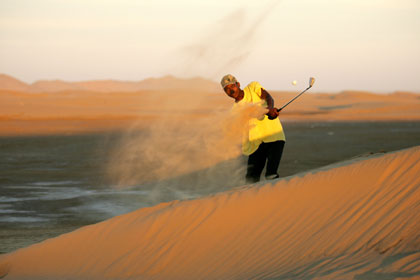Williams is the only golf professional offering coaching in Namibia, but free
golf balls and old sets of clubs are sent through to smaller towns, such as port
city Walvis Bay.

Namibian Johnny Shebel
plays a shot on a roadside desert golf track in Walvis Bay, Namibia in
this May 16, 2006 file photo. The nine-hole course dubbed the "West Side
Club" has no greens or tees, water or grass. Stinging sand and gusts of
wind whistle through a lone row of palm trees on the edge of the
forbidding Namib desert. [Reuters] |
Namibia,
with just two million people, has been thrust into the spotlight with the
surprise arrival of Hollywood stars Brad Pitt and Angelina Jolie to have their
first baby in the remote west coast region.
But Gubeb and his friends show little interest in the film stars, preferring
to dream of golf greatness as they perfect their skills on a course where the
roughs are rougher than most.
SAND AND OIL
Kuludu says he has played the informal desert track, next to the main road
between Walvis Bay and tourist town Swakopmund, for eight years.
He can play whenever he wants and there are no fees, unlike the nearby Walvis
Bay club -- one of only two courses for hundreds of kilometers where grass takes
tentative hold amid the creeping desert.
There are only four grass courses in Namibia -- a country slightly smaller
than France and Germany combined -- although almost all other reasonably-sized
towns have "courses" made of a mixture of sand and oil.
The West Side Club has neither grass nor oil but the frustrations of the game
are as brutally real as on any golf course.
Cries of disapproval pierce the dry air as Gubeb tees up his ball just
outside the imaginary line that separates the sand fairway from the equally
sandy rough.
Players aim for a shallow hand-dug hole in the ground almost invisible to
newcomers, while scores are scratched onto a piece of cardboard.
The course's nine holes range from 110 meters (yards) on the par 3s to about
350 meters for a par 5, although the distances, after many years, remain an
educated guess.
The golfers carry their own tee pegs, an allowance for the state of the
"fairways," and players scour the area for fear of losing their only ball.
Despite the obstacles, 19-year-old Joseph Ikela fashions a perfect draw.
"I want to make a living out of it. Here in Namibia there aren't too many
golf players amongst us blacks. I want to put the country on the map."
The group's members share one set of second-hand clubs, mostly ones discarded
by other golfers. The bag is worn down by the gritty desert sand and the sticks
are a hodgepodge of makes and sizes.
Their second bag was stolen three months ago, while they were playing just a
short sprint from the main west coast road and adjacent township.
"I know it's a rich man's game, but we just want to try," explains Gubeb over
the din of laughter as a 17-year-old novice burrows the Hippo driver into the
sand, gently toppling the ball from the tee.